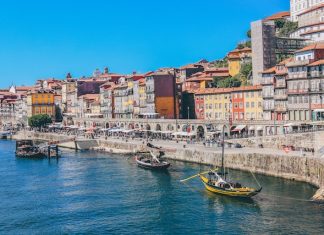Part of the Republic of Ecuador, the Galapagos Islands are a small archipelago of islands with beautiful beaches in the Pacific Ocean, about 1000 kilometers (or 620 miles) off the South American continent on its western side.
The archipelago consists of 13 main islands and 6 smaller islands, which cover some 50,000 square kilometers (or 19.500 square miles) of the ocean. Of this area, which consists of some 8,000 square kilometers of land, 97% belong to a National Park since 1959. No wonder the Galapagos Islands are famous for their wildlife, which inspired Charles Darwin’s Theory of Natural Selection.
Giant tortoises, marine iguanas, sea lions, penguins, and several species of birds make up the wildlife of these islands, where the landscape is generally very volcanic and barren but still very beautiful. The Wolf Volcano is the highest mountain on the island and is 1707 meters high. The Galapagos Islands have been, since 1978, a UNESCO World Heritage Site.
Getting there:
A trip to the Galapagos Islands is a costly undertaking, as the archipelago has a remote location in the Pacific Ocean, far from the continental land. Flights to Baltra airport, in Galapagos, depart daily in the morning from Quito (2 daily flights) and Guayaquil (one flight a day, cheaper than Quito). However, the returns are in the afternoon, so you usually have to spend a night in continental Ecuador on your way to the island and then again on your way back.
Tame, Aerogal, and LAN are the airlines flying to the islands, and the price for foreigners went from slightly over 400 to a bit more than 500 U.S. dollars in March 2012 but varied according to the season. In addition, there are 15-20% discounts with an international student card (ISIC) and a 50% discount for Ecuatorian travelers. You must pay USD 10 in continental Ecuador as a “visa” to enter Galapagos and then USD 100 upon arrival to the Galapagos Islands, which is the cost of the park’s admission.
Flights between the islands of Baltra or San Cristobal to Isabela cost about $ 260 roundtrip. Baltra is a 20-minute walk from the center of Puerto Baquerizo Moreno and two hours by public transport to Puerto Aroya, the main town of Santa Cruz, the central island of the Galapagos.
You can also reach any of the five ports of the Galapagos Islands on private yachts, which are allowed to be there to handle 21 days without a permit. In addition, cargo ships travel to the Galapagos weekly but are not entitled to transfer passengers.
What to do in Galapagos Islands?
Some speak of the Galapagos Islands as a living laboratory where you can appreciate the beauty of nature. Historians, biologists, and anyone interested in evolution and life feel at home in the Galapagos Islands, with more than 2,500 marine species and green waters due to the strong presence of algae.
Baltra and Santa Cruz islands are great places to spot baby turtles. Turtle’s Bay Beach is surrounded by pristine wilderness. In Bachas, you will find two beautiful beaches for snorkeling, while Blaze Sur Island will allow you to see iguanas and a colony of sea lions.
Boat trips are an excellent opportunity to reach the more remote islands. Cruises last between 2 and 15 days, in which you can, for example, climb the mountain of Bartolome and see the Galapagos Islands from above, visit the Charles Darwin Research Center and learn about its program of breeding and rearing the giant tortoises on Santa Cruz. Watching the colorful species of Galapagos penguins in Isabela and Floreana, snorkeling with sea lions and turtles of the Pacific. Other water activities include scuba diving, surfing, and kayaking. Horseback riding, hiking, and biking are also exciting options in Galapagos.
When visiting the Galapagos Islands?
The weather in the Galapagos Islands varies greatly. The hottest and most humid season lasts from December to June, especially April. The water is ideal for those who like diving and snorkeling. The average temperature is between 26-30 C, with occasional rain and warm and sunny days. Between May and November, the temperature drops for the dry season. There are cold winds and drizzle, with temperatures of 20-24 C during the day and lower at night (up to 7 C).
While tourists seeking nature visit the island between December and May, the summer months from June to August are sought after by animal lovers since that’s when animals are the most active. The season runs from September to November, but for those who perform diving and want to see sharks, it is recommended to visit the Galapagos Islands between July and November.








